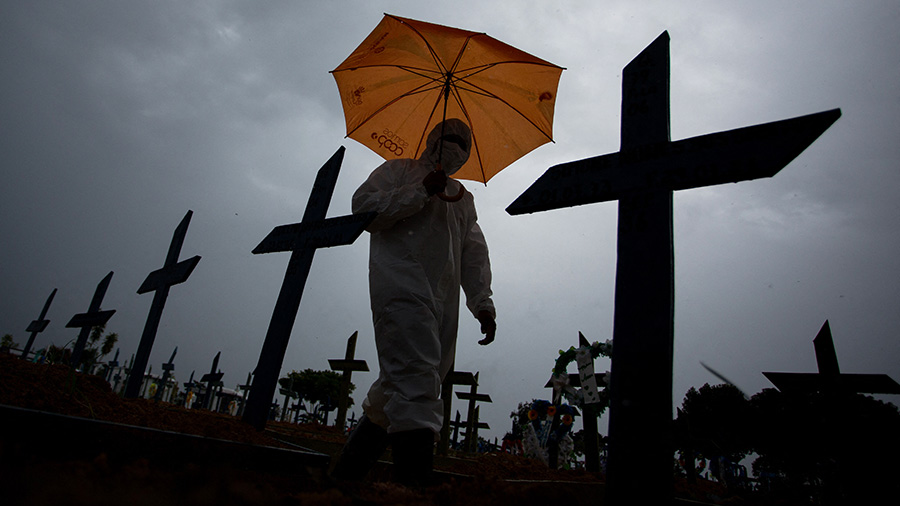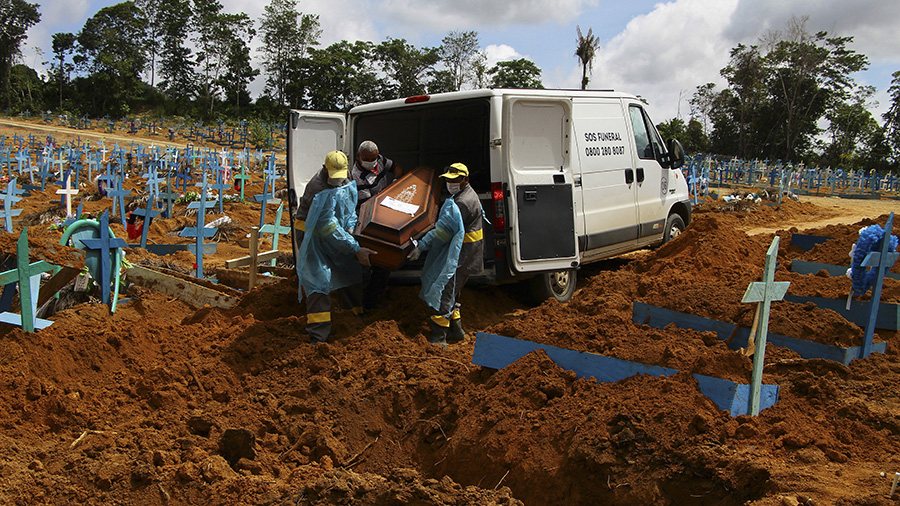When the COVID-19 variant globally known as the "Brazilian variant" or more officially as Brazil P.1 was first identified in the South American in January 2021, many countries across the world took steps they hoped would stop it spreading.
And yet, cases have now been recorded across the world, including in countries such as the U.S., the Republic of Korea, Ireland, the UK, Italy, Spain and France.
Cases of another variant first detected in Brazil around the same time, known as P.2, were also detected in the UK in January, but this variant doesn't concern the experts as much as the first. Six new cases of the P.1 variant were identified in the UK on Sunday, raising alarm for experts, who are now attempting to track down all those infected.

A worker wearing a protective suit and carrying an umbrella walks past the graves of COVID-19 victims at the Nossa Senhora Aparecida cemetery, in Manaus, Brazil, on February 25, 2021. /Michael Dantas/AFP
A worker wearing a protective suit and carrying an umbrella walks past the graves of COVID-19 victims at the Nossa Senhora Aparecida cemetery, in Manaus, Brazil, on February 25, 2021. /Michael Dantas/AFP
Viruses mutate and change all the time, the majority of the time with very little consequences. But the mutations of the COVID-19 virus first reported in the UK, Brazil and South Africa are rising real concerns over these new variants' potential for infection and resistance to the currently available vaccines.
What is the Brazil variant?
Though all variants arose independently, the Brazilian variant presents three key mutations in its spike proteins N501Y, E484K and K417N, alongside other changes, which it shares in part with the South Africa B.1.351 variant and the B.1.1.7 variant first discovered in the UK.
The N501Y variant has been shown to make it easier for the virus to attach itself to human cells, making it more easily transmissible, while the mutation in the E484K protein, which is not present in the UK-discovered variant but is also found in the South Africa variant, has been shown to be more effective in reducing people's antibody recognition of the virus.
This is possibly the reason why the Brazil variant has been linked to cases of reinfection in patients who had already suffered from the original strain of COVID-19.
How was it discovered?
According to the experts, the Brazilian variant P.1 had already started spreading across the population of Manaus, in the state of Amazonas at the end of 2020.
It was first officially detected by authorities in Japan in four Japanese travelers returning from a trip to the Amazon in January. The discovery was quickly followed by an explosion of new cases in Manaus, an area that was previously considered to have achieved herd immunity after suffering greatly from the original strain.
According to Brazil's National Council of Health Secretaries, new infections surged by 125 percent in the region between January 7 and 22. Many patients died of asphyxiation as hospitals in the region were overwhelmed by the rising number of new patients and quickly ran out of precious oxygen.

Manaus declared on January 5 a 180-day state of emergency due to a surge of new cases of coronavirus. Brazil has now surpassed 250,000 deaths due to COVID-19. /AP/Edmar Barros
Manaus declared on January 5 a 180-day state of emergency due to a surge of new cases of coronavirus. Brazil has now surpassed 250,000 deaths due to COVID-19. /AP/Edmar Barros
How did the variant evade herd immunity?
During the first wave of COVID-19, Manaus reported around 80 deaths each day in May 2020, a tragic number which led the city to become the first in Brazil city to dig mass graves for COVID-19-related deaths.
By October 2020, 76 percent of the population had been infected (based on samples of antibodies found in blood donors), leading experts to believe Manaus was likely to have reached herd immunity, though at a great cost.
But in January 2021, the daily number of COVID-19 deaths was around 100 a day, even higher than in 2020.
Though the reasons behind the new wave of cases in the region can be traced back to multiple factors, including more relaxed behaviour in the local community, experts theorize that the P.1 variant might have played a significant role in the rise in infections thanks to its ability, due to the mutation in its spike proteins, to evade antibodies and reinfect people.
Studies have also shown that we can't really rely on herd immunity to guarantee protection against new infections.
The John Snow Memorandum statement signed by more than 6,900 scientists, researchers and healthcare professionals last year, said: "There is no evidence for lasting protective immunity to SARS-CoV-2 following natural infection and the endemic transmission that would be the consequence of waning immunity would present a risk to vulnerable populations for the indefinite future."
Do vaccines work against it?
There's no proof yet that the currently available COVID-19 vaccines will be less effective against this variant.
Early results have shown the Pfizer-BioNTech vaccine is likely to work against all new variants.
Experts agree that developing a new jab against the new strains of the virus would be a quicker job than manufacturing a vaccine from scratch, as was the case for the ones the world was racing to produce last year. In the case of the new mutations, scientists might "only" need to tweak the existing vaccines to adapt to the variants.
A potential reduced vaccine efficacy wouldn't mean, anyway, that the variants would be able to elude vaccines entirely. The vaccines would still be effective, only to a lesser degree.
Although the potential for higher transmission and a higher rate of reinfection of the variants are concerning, the key to defeating the virus and any of its mutations is still to control the spread of the infection.
New mutations are likely to evolve as the virus continues spreading across the population and it will be essential scientists and experts keep monitoring these changes.
Cover image: NIAID-RML via AP

